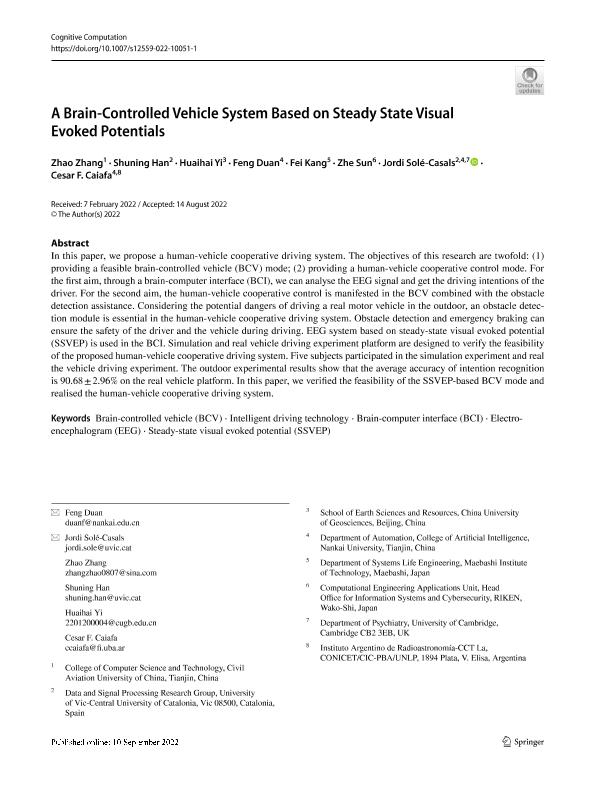Artículo
A Brain-Controlled Vehicle System Based on Steady State Visual Evoked Potentials
Zhang, Zhao; Han, Shuning; Yi, Huaihai; Duan, Feng; Kang, Fei; Sun, Zhe; Solé Casals, Jordi; Caiafa, César Federico

Fecha de publicación:
09/2022
Editorial:
Springer
Revista:
Cognitive Computation
ISSN:
1866-9956
e-ISSN:
1866-9964
Idioma:
Inglés
Tipo de recurso:
Artículo publicado
Clasificación temática:
Resumen
In this paper, we propose a human-vehicle cooperative driving system. The objectives of this research are twofold: (1) providing a feasible brain-controlled vehicle (BCV) mode; (2) providing a human-vehicle cooperative control mode. For the first aim, through a brain-computer interface (BCI), we can analyse the EEG signal and get the driving intentions of the driver. For the second aim, the human-vehicle cooperative control is manifested in the BCV combined with the obstacle detection assistance. Considering the potential dangers of driving a real motor vehicle in the outdoor, an obstacle detection module is essential in the human-vehicle cooperative driving system. Obstacle detection and emergency braking can ensure the safety of the driver and the vehicle during driving. EEG system based on steady-state visual evoked potential (SSVEP) is used in the BCI. Simulation and real vehicle driving experiment platform are designed to verify the feasibility of the proposed human-vehicle cooperative driving system. Five subjects participated in the simulation experiment and real the vehicle driving experiment. The outdoor experimental results show that the average accuracy of intention recognition is 90.68 ± 2.96% on the real vehicle platform. In this paper, we verified the feasibility of the SSVEP-based BCV mode and realised the human-vehicle cooperative driving system.
Archivos asociados
Licencia
Identificadores
Colecciones
Articulos(IAR)
Articulos de INST.ARG.DE RADIOASTRONOMIA (I)
Articulos de INST.ARG.DE RADIOASTRONOMIA (I)
Citación
Zhang, Zhao; Han, Shuning; Yi, Huaihai; Duan, Feng; Kang, Fei; et al.; A Brain-Controlled Vehicle System Based on Steady State Visual Evoked Potentials; Springer; Cognitive Computation; 15; 1; 9-2022; 159-175
Compartir
Altmétricas



